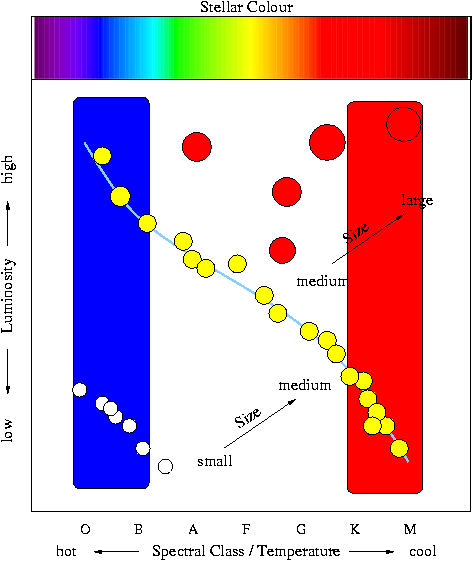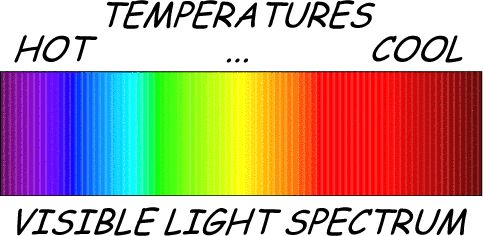

Summary of results:
Maria Mitchell's score on this quiz was 60% (any incorrect choices are highlighted in red).
#1. Which of the following waves travels the fastest?
#2. Consider two stars X and Y, where X is an M-type star and Y is an O-type star. Which star is larger?
#3. The least massive stars remain on the Main Sequence for the amount of time.
#4. If an object is projected away from a planet at a speed near to but significantly less than the escape velocity, it will .
#5. The figure drawn below consists of optical spectra for two galaxies, showing a
set of common emission or absorption line features in both spectra. The top
spectrum contains features at the wavelengths at which they are observed in
the laboratory, while the bottom spectrum shows these features as they would
appear in the spectrum of another galaxy, one moving relative to the Milky Way.
Calculate the distance (in units of megaparsecs) that the other galaxy must
lie away from the Milky Way, if the expansion rate of the Universe is
Ho = 72 kilometers per second per megaparsec, in order to produce
the observed shift in the wavelength of the spectral features.
Recall that the speed of light, c, is equal to 300,000 kilometers per second.
Elapsed Time: 5.46 minutes
#1.
Which of the following waves travels the fastest?| ocean waves | sound waves |
| light waves | The Queen of England waving her hand. |
Light waves (electromagnetic waves) travel at the speed of light, which is 300,000 kilometers per second. The speed of sound at sea level is about 0.34 kilometers per second. The speed of ocean waves varies, but the fastest are large tsunami, which can travel as fast as a jet airliner (0.3 kilometers per second). Given these speeds you can see that light travels incredibly fast; approximately one million times faster than a jet airliner.


#2.
Consider two stars X and Y, where X is an M-type star and Y is an O-type star. Which star is larger?| X | Y |
| The two stars are the same size. | |
| We need more information to answer this question. | |
We know that O-type stars lie on the left-hand side of the Hertzsprung-Russell Diagram, and have hot, blue colors, while M-type stars lie on the right-hand side and are cool stars with reddish colors. The two long rectangular regions on the plot shown below indicate where they are found.
Though O-type stars are hotter and bluer than M-type stars, they could be larger or they could be smaller. The brightest O-type star is larger than the faintest M-type star, but a bright M-type giant could be larger than many O-type stars.

We know the relation between a star's luminosity, radius, and temperature,



#3.
The least massive stars remain on the Main Sequence for the amount of time.| shortest | longest |
One might think that the most massive stars would stay longest in the Main Sequence burning phase, as they have the most fuel available to burn (mass to convert to energy). However, their high mass leads to a higher internal temperature and increased efficiency in nuclear burning; in effect, they live shorter, hotter lives and burn through their hydrogen and helium in a flash.


#4.
If an object is projected away from a planet at a speed near to but significantly less than the escape velocity, it will .| rise high into the atmosphere, and then settle into a stable orbit |
| travel to a certain distance above the surface, but then fall back down |
| continue to move away from the planet forever, at an ever-decreasing speed |
| continue to move away from the planet forever, at a constant speed |
| be unable to launch successfully |
A projectile launched from the surface of a planet at less then the escape velocity will not have enough kinetic energy (energy of motion) to escape the gravitational pull of the planet. It will initially rise up into the sky (much like a baseball hit deep into the outfield), but its energy will take it only so high. It will then fall back down to Earth.


#5.
The figure drawn below consists of optical spectra for two galaxies, showing a set of common emission or absorption line features in both spectra. The top spectrum contains features at the wavelengths at which they are observed in the laboratory, while the bottom spectrum shows these features as they would appear in the spectrum of another galaxy, one moving relative to the Milky Way.Calculate the distance (in units of megaparsecs) that the other galaxy must lie away from the Milky Way, if the expansion rate of the Universe is Ho = 72 kilometers per second per megaparsec, in order to produce the observed shift in the wavelength of the spectral features. Recall that the speed of light, c, is equal to 300,000 kilometers per second.

We can see that all of the emission line features in the top spectrum have shifted to the right in the lower spectrum. The peak at 4340 Angstroms, for example, has shifted over by 33 Angstroms to 4373 Angstroms, while the peak at 4861 Angstroms has shifted over by 36 Angstroms to 4897 Angstroms. Note that there is an extra feature in the lower spectrum at 3918 Angstroms which fell outside of our spectrum in the upper plot.
As all features have shifted to the right, to longer wavelengths and redder colours, we say that this spectrum is redshifted and conclude that the galaxy is moving away from us. We can calculate its velocity from the shift in wavelength of the line features. Using our measurements of the line at 4861 Angstroms, we see that

Solving for the velocity, we find that

We can then use the expansion rate of the Universe to equate the galaxy velocity with the distance that it lies from us.


